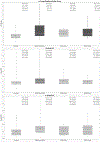Multiple breath washout: A noninvasive tool for identifying lung disease in symptomatic military deployers
- PMID: 33340829
- PMCID: PMC8048067
- DOI: 10.1016/j.rmed.2020.106281
Multiple breath washout: A noninvasive tool for identifying lung disease in symptomatic military deployers
Abstract
Rationale: Military deployments to austere environments since November 9, 2001 may put "deployers" at risk for respiratory disease. Sensitive, noninvasive tools for detecting large and small airways injury are needed to identify early disease and help inform management for this at-risk population.
Objectives: We examined multiple breath washout (MBW) as a tool for identifying deployment-related airways disease and assessed host and exposure risk factors compared to healthy controls.
Methods: Between March 2015 and March 2020, 103 healthy controls and 71 symptomatic deployers with asthma and/or distal lung disease completed a questionnaire, spirometry and MBW testing. SAS v. 9.4 was used to compare MBW parameters between deployers and controls via univariate analyses and adjusted for demographic factors using multiple linear regression.
Measurements and main results: Deployers were significantly more likely than controls to have an abnormal lung clearance index (LCI) score indicating global ventilation inhomogeneity. Adjusting for sex, smoking status, smoking pack-years and body mass index, LCI scores were significantly more abnormal among those with deployment-related asthma and distal lung disease compared to controls. The unadjusted variable Sacin (a marker of ventilation inhomogeneity in the acinar airways) was higher and thus more abnormal in those with both proximal and distal airways disease. Deployers who reported more frequent exposure to explosive blasts had significantly higher LCI scores.
Conclusions: This study demonstrates the utility of MBW in evaluating exposure-related airways disease in symptomatic military personnel following deployment to austere environments, and is the first to link exposure to explosive blasts to measurable small airways injury.
Keywords: Lung clearance index; Military deployment; Multiple breath washout; Occupational exposure.
Copyright © 2020 The Author(s). Published by Elsevier Ltd.. All rights reserved.
Figures


References
-
- Smith B, Wong CA, Smith TC, Boyko EJ, Gackstetter GD, Margaret AKRftMCST. Newly reported respiratory symptoms and conditions among military personnel deployed to Iraq and Afghanistan: a prospective population-based study. Am J Epidemiol 2009; 170: 1433–1442. - PubMed
-
- Szema AM, Peters MC, Weissinger KM, Gagliano CA, Chen JJ. New-onset asthma among soldiers serving in Iraq and Afghanistan. Allergy Asthma Proc 2010; 31: 67–71. - PubMed
-
- Morris MJ, Walter RJ, McCann ET, Sherner JH, Murillo CG, Barber BS, Hunninghake JC, Holley AB. Clinical Evaluation of Deployed Military Personnel With Chronic Respiratory Symptoms: Study of Active Duty Military for Pulmonary Disease Related to Environmental Deployment Exposures (STAMPEDE) III. Chest 2020. - PubMed
Publication types
MeSH terms
Substances
Grants and funding
LinkOut - more resources
Full Text Sources
Other Literature Sources
Medical

